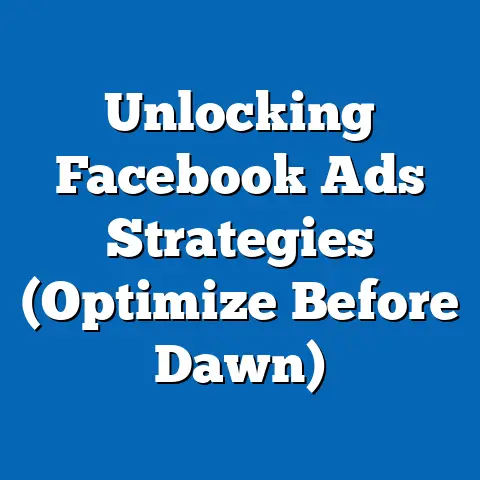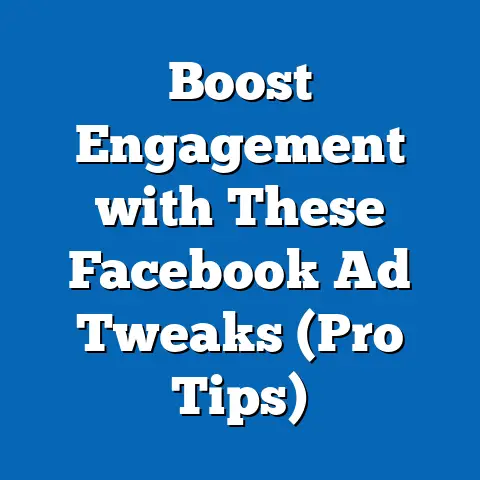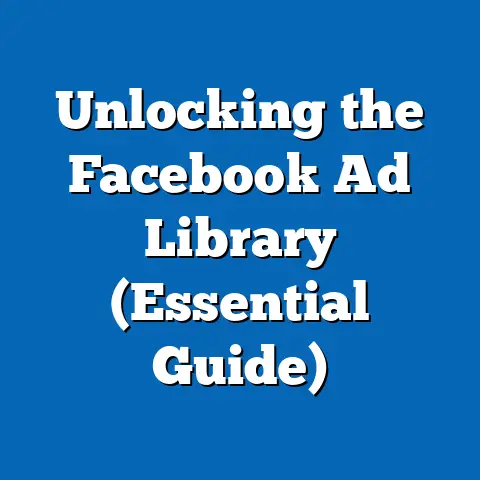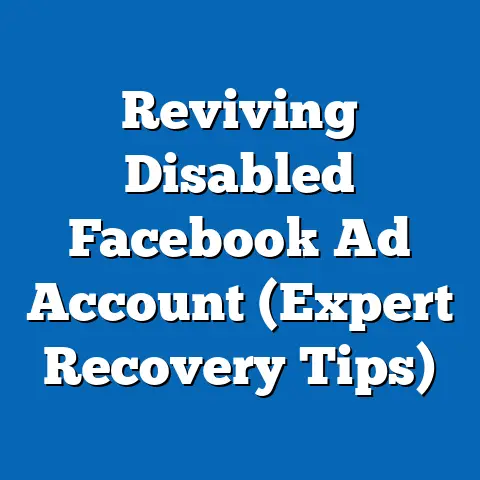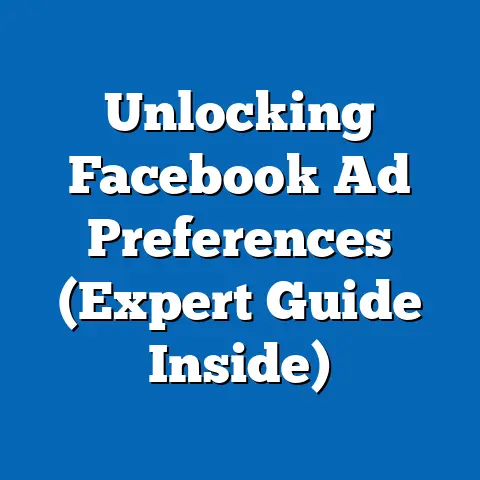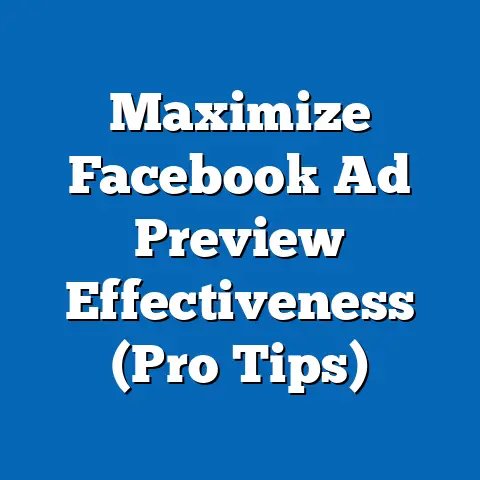Boost CTR for Facebook Ads (Expert Strategies Revealed)
In the ever-evolving world of digital marketing, standing still is the same as falling behind. I’ve seen this firsthand time and again, especially within the fast-paced landscape of Facebook advertising. What worked last month might be obsolete today, thanks to algorithm updates, shifting user behavior, and the constant influx of new ad formats. That’s why adaptability is so critical. It’s not enough to simply launch a campaign; you need to be prepared to tweak, test, and transform your approach continuously. At the heart of successful Facebook advertising lies the Click-Through Rate (CTR). It’s more than just a number; it’s a vital sign, indicating how well your ads resonate with your target audience. Boosting your CTR is about more than just getting clicks; it’s about improving your campaign’s overall performance, optimizing your budget, and ultimately driving conversions.
In this guide, I’m going to share expert strategies I’ve learned over years of managing Facebook ad campaigns – strategies designed to help you boost your CTR and achieve better results. We’ll dive deep into the psychology behind clicks, crafting compelling ad copy, leveraging visual elements, mastering audience targeting, and the power of A/B testing.
1. Understanding CTR in the Context of Facebook Ads
Let’s start with the fundamentals. Click-Through Rate (CTR) is the percentage of people who see your ad and then click on it. It’s calculated by dividing the number of clicks your ad receives by the number of times it’s shown (impressions), then multiplying by 100.
Why is CTR so important?
- Relevance Indicator: A high CTR indicates that your ad is relevant to the audience you’re targeting. Facebook’s algorithm rewards relevant ads with lower costs and better placement.
- Quality Score: CTR contributes to your ad’s Quality Score, which impacts how often your ad is shown and how much you pay.
- Cost Efficiency: A higher CTR means you’re getting more clicks for your budget, effectively lowering your cost per click (CPC).
- Improved ROI: Ultimately, a higher CTR leads to more traffic to your website or landing page, increasing your chances of conversions and a better return on investment (ROI).
What’s a good CTR on Facebook? This is where things get tricky. There’s no one-size-fits-all answer. Average CTRs vary significantly based on industry, ad format, targeting, and even the time of year.
- Across industries, the average CTR for Facebook ads hovers around 0.9% (Source: various marketing reports). However, I’ve seen CTRs range from 0.5% to 5% or even higher, depending on the specific campaign.
- For example, I once worked with an e-commerce client in the fashion industry, and we consistently achieved CTRs above 2% by using highly targeted ads featuring user-generated content.
Takeaway: Don’t get hung up on industry averages. Focus on improving your own CTR over time. Track your performance, identify what works, and continually optimize your campaigns.
2. The Psychology Behind Clicks
Understanding why people click is crucial to crafting effective ads. It’s not just about showcasing your product or service; it’s about tapping into the psychological triggers that motivate action.
Here are some key psychological principles I’ve found particularly effective:
-
Curiosity: Humans are naturally curious. Create ads that pique their interest and make them want to learn more. Use intriguing headlines, ask thought-provoking questions, or hint at a solution to a common problem. I often use “how-to” headlines or questions like, “Are you making these mistakes with your [product/service]?”
-
Urgency: Creating a sense of urgency can compel people to click immediately. Use phrases like “Limited Time Offer,” “Sale Ends Soon,” or “Act Now.” I’ve seen this work especially well for time-sensitive promotions or events. One time, I ran a campaign for a local restaurant offering a discount on reservations made within 24 hours, and the CTR skyrocketed.
-
Relevance: People are more likely to click on ads that are relevant to their interests, needs, and pain points. This is where precise audience targeting comes into play (more on that later). Use ad copy and visuals that speak directly to your target audience. For example, if you’re targeting new parents, use images of babies and families and address common concerns like sleep deprivation or feeding issues.
-
Social Proof: People are influenced by the actions and opinions of others. Incorporate social proof into your ads by showcasing testimonials, reviews, or the number of customers you’ve served. I’ve had great success using ads that feature quotes from satisfied customers or highlighting the popularity of a particular product.
-
Value Proposition: Clearly communicate the value you’re offering. What problem does your product or service solve? What benefits will customers receive? Make your value proposition clear and compelling. Instead of just saying “We sell shoes,” say “Find the perfect shoes for your active lifestyle, guaranteed comfort and style.”
Curiosity: Humans are naturally curious. Create ads that pique their interest and make them want to learn more. Use intriguing headlines, ask thought-provoking questions, or hint at a solution to a common problem. I often use “how-to” headlines or questions like, “Are you making these mistakes with your [product/service]?”
Urgency: Creating a sense of urgency can compel people to click immediately. Use phrases like “Limited Time Offer,” “Sale Ends Soon,” or “Act Now.” I’ve seen this work especially well for time-sensitive promotions or events. One time, I ran a campaign for a local restaurant offering a discount on reservations made within 24 hours, and the CTR skyrocketed.
Relevance: People are more likely to click on ads that are relevant to their interests, needs, and pain points. This is where precise audience targeting comes into play (more on that later). Use ad copy and visuals that speak directly to your target audience. For example, if you’re targeting new parents, use images of babies and families and address common concerns like sleep deprivation or feeding issues.
Social Proof: People are influenced by the actions and opinions of others. Incorporate social proof into your ads by showcasing testimonials, reviews, or the number of customers you’ve served. I’ve had great success using ads that feature quotes from satisfied customers or highlighting the popularity of a particular product.
Value Proposition: Clearly communicate the value you’re offering. What problem does your product or service solve? What benefits will customers receive? Make your value proposition clear and compelling. Instead of just saying “We sell shoes,” say “Find the perfect shoes for your active lifestyle, guaranteed comfort and style.”
Example:
I remember a campaign I ran for a software company that offered a free trial. Instead of just saying “Try our software for free,” we used the headline “Stop Wasting Time on [Problem] – Get a Free Trial of [Software] and See Results in 7 Days!” This headline tapped into the pain point of wasted time, offered a solution (the software), and created a sense of urgency with the “7 Days” timeframe. The CTR was significantly higher than previous campaigns.
Takeaway: Think like your target audience. What motivates them? What are their pain points? What value are they seeking? Use these insights to craft ads that resonate with them on a psychological level.
3. Crafting Compelling Ad Copy
Your ad copy is the voice of your brand. It’s what communicates your message, captures attention, and persuades people to click. Here’s my breakdown of the elements of high-converting ad copy:
- Headline: This is the first thing people see, so make it count. It should be attention-grabbing, concise, and relevant to your target audience. Use power words, ask questions, or make a bold statement.
- Body Text: This provides more detail about your offer. Highlight the benefits, address pain points, and explain why people should click. Keep it concise and easy to read. Use short sentences and bullet points to break up the text.
- Call to Action (CTA): Tell people what you want them to do. Use clear and direct CTAs like “Shop Now,” “Learn More,” “Sign Up,” or “Get Started.” Your CTA should be prominent and visually appealing.
Expert Tips for Writing High-Converting Ad Copy:
- Know Your Audience: Understand their language, their needs, and their desires. Use words and phrases that resonate with them.
- Focus on Benefits, Not Features: People care more about what your product or service can do for them than about its technical specifications. Highlight the benefits and how they solve problems.
- Use Power Words: These are words that evoke emotion and create a sense of urgency or excitement. Examples include “Free,” “New,” “Exclusive,” “Secret,” “Proven,” and “Guaranteed.”
- Keep it Concise: People have short attention spans. Get to the point quickly and avoid jargon or overly technical language.
- A/B Test Different Versions: Experiment with different headlines, body text, and CTAs to see what performs best.
Example:
I once worked with a local bakery that was struggling to attract new customers. Their initial ad copy was generic and uninspiring. We rewrote their ad copy to focus on the emotional connection people have with baked goods.
- Original Headline: “Best Bakery in Town”
- Revised Headline: “Indulge Your Sweet Tooth – Freshly Baked Treats Made with Love”
The revised headline used emotional language and highlighted the quality and care that went into their products. The CTR increased by over 30%.
Takeaway: Your ad copy is your sales pitch. Make it compelling, relevant, and persuasive. Focus on the benefits, use power words, and always test different versions to optimize your results.
4. Visual Elements That Capture Attention
In the visually driven world of Facebook, your ad’s visual elements are just as important as your ad copy. A compelling image or video can stop people in their tracks and entice them to click.
- High-Quality Images: Use images that are clear, well-lit, and visually appealing. Avoid blurry or pixelated images.
- Relevant Images: Choose images that are relevant to your product, service, and target audience.
- Eye-Catching Visuals: Use images that are visually striking and stand out from the crowd. Consider using bright colors, interesting compositions, or unique perspectives.
- Videos: Videos are highly engaging and can be a great way to showcase your product or service. Keep your videos short, attention-grabbing, and mobile-friendly.
- Graphics: Use graphics to highlight key information or create a visually appealing design.
Guidelines for Choosing the Right Visuals:
- Color Psychology: Understand how different colors evoke different emotions. Use colors that are appropriate for your brand and message. For example, blue is often associated with trust and reliability, while red is associated with excitement and energy.
- Image Dimensions: Use the correct image dimensions for each ad format. Facebook provides specific guidelines for image sizes. Using the wrong dimensions can result in distorted or cropped images.
- Video Length: Keep your videos short and to the point. The ideal video length for Facebook ads is typically between 15 and 60 seconds.
Example:
I worked with a travel company that was promoting a new tour package. Their initial ads used generic stock photos of tourist destinations. We replaced these with authentic photos taken by previous customers on the tour. The new ads were much more engaging and resulted in a significant increase in CTR.
Takeaway: Invest in high-quality visuals that are relevant, eye-catching, and optimized for Facebook’s ad formats. Consider using videos to showcase your product or service in action.
5. Targeting the Right Audience
Even the most compelling ad copy and visuals will fall flat if you’re not targeting the right audience. Precise audience targeting is essential for maximizing your CTR and achieving your advertising goals.
Here are the targeting options available on Facebook:
- Demographics: Target people based on age, gender, location, education, and other demographic information.
- Interests: Target people based on their interests, hobbies, and pages they’ve liked on Facebook.
- Behaviors: Target people based on their online behavior, such as their purchase history, travel habits, and device usage.
- Custom Audiences: Create custom audiences based on your existing customer data, website traffic, or app activity.
- Lookalike Audiences: Expand your reach by creating lookalike audiences based on your existing custom audiences.
Strategies for Refining Audience Targeting:
- Start Broad: Begin with a broad audience and then narrow down your targeting based on performance data.
- Layer Targeting Options: Combine different targeting options to create a more specific audience. For example, you could target women aged 25-34 who are interested in fashion and have recently purchased clothing online.
- Use Exclusion Targeting: Exclude people who are not likely to be interested in your offer. For example, you could exclude people who have already purchased your product or service.
- Test Different Audiences: Experiment with different audience targeting options to see what performs best.
- Monitor Performance: Track your audience performance and adjust your targeting accordingly.
Example:
I worked with a fitness studio that was promoting a new yoga class. Their initial ads targeted a broad audience of people interested in fitness. We refined their targeting to focus on women aged 25-44 who were interested in yoga and had recently visited a health and wellness website. The new ads were much more effective, resulting in a significant increase in CTR and sign-ups.
Takeaway: Don’t assume you know your target audience. Research their demographics, interests, and behaviors. Use Facebook’s targeting options to reach the most relevant users and continually refine your targeting based on performance data.
6. A/B Testing for Continuous Improvement
A/B testing, also known as split testing, is the process of comparing two versions of an ad to see which one performs better. It’s an essential tool for optimizing your ad performance and boosting your CTR.
Here’s how to set up A/B tests for different ad elements:
- Headline: Test different headlines to see which ones are most attention-grabbing and relevant.
- Body Text: Test different body text to see which ones are most persuasive and informative.
- Visuals: Test different images and videos to see which ones are most engaging and visually appealing.
- Call to Action: Test different CTAs to see which ones are most likely to drive clicks.
- Audience Targeting: Test different audience targeting options to see which ones are most responsive.
Case Study:
I once worked with an e-commerce company that was running a Facebook ad campaign to promote a new line of clothing. We ran an A/B test to compare two different headlines:
- Headline A: “New Clothing Line – Shop Now!”
- Headline B: “Get the Latest Styles – Free Shipping on Orders Over $50!”
Headline B included a more specific value proposition (free shipping) and created a sense of urgency. The results showed that Headline B had a CTR that was 40% higher than Headline A. We then used Headline B for the rest of the campaign, resulting in a significant increase in sales.
Takeaway: A/B testing is a continuous process. Don’t just run one test and then stop. Continually experiment with different ad elements to see what performs best and optimize your campaigns for maximum results.
7. Leveraging Facebook Ad Formats
Facebook offers a variety of ad formats, each with its own unique advantages. Choosing the right ad format can significantly impact your CTR and overall campaign performance.
Here are some of the most popular Facebook ad formats:
- Image Ads: These are simple and straightforward ads that feature a single image and ad copy. They’re great for showcasing a product or service in a visually appealing way.
- Video Ads: These are highly engaging ads that feature a video and ad copy. They’re great for telling a story, demonstrating a product, or showcasing your brand personality.
- Carousel Ads: These ads feature multiple images or videos that users can scroll through. They’re great for showcasing multiple products, highlighting different features, or telling a story in a sequence.
- Slideshow Ads: These ads combine multiple images into a slideshow video. They’re a cost-effective way to create engaging video content.
- Collection Ads: These ads feature a cover image or video and a collection of products that users can browse. They’re great for e-commerce businesses looking to showcase their product catalog.
- Instant Experience Ads: These ads open into a full-screen, mobile-optimized experience. They’re great for creating immersive brand experiences and driving conversions.
Tips for Creatively Incorporating Ad Formats:
- Carousel Ads for Storytelling: Use carousel ads to tell a story or showcase the different steps in a process.
- Video Ads for Demonstrations: Use video ads to demonstrate how your product works or showcase its benefits.
- Collection Ads for Product Discovery: Use collection ads to help users discover new products in your catalog.
- Instant Experience Ads for Immersive Experiences: Use instant experience ads to create a fully immersive brand experience that drives conversions.
Takeaway: Experiment with different ad formats to see what works best for your product, service, and target audience. Don’t be afraid to get creative and think outside the box.
8. Analyzing and Adapting Strategies
Here’s how to interpret Facebook Ads Manager data:
- CTR: Track your CTR over time to see how your ads are performing. A declining CTR may indicate that your ads are becoming stale or that your targeting needs to be refined.
- Impressions: Track your impressions to see how many people are seeing your ads. A low number of impressions may indicate that your budget is too low or that your targeting is too narrow.
- Reach: Track your reach to see how many unique people are seeing your ads. A low reach may indicate that your targeting is too narrow or that your ads are not engaging enough.
- Cost Per Click (CPC): Track your CPC to see how much you’re paying for each click. A high CPC may indicate that your ads are not relevant or that your targeting is too broad.
- Conversions: Track your conversions to see how many people are taking the desired action, such as making a purchase or signing up for a newsletter.
The Need for Ongoing Adaptation:
The Facebook advertising landscape is constantly changing. Algorithms are updated, user behavior shifts, and new ad formats are introduced. To stay ahead of the curve, you need to be constantly analyzing your ad performance and adapting your strategies accordingly.
Takeaway: Analytics are your best friend. Use Facebook Ads Manager to track your ad performance, identify trends, and make data-driven decisions. Be prepared to adapt your strategies based on the data and stay up-to-date with the latest changes in the Facebook advertising landscape.
Conclusion
Boosting your CTR on Facebook ads is an ongoing process that requires a combination of creativity, data analysis, and adaptability. By understanding the psychology behind clicks, crafting compelling ad copy, leveraging visual elements, mastering audience targeting, and continually A/B testing your ads, you can significantly improve your CTR and achieve better results from your Facebook advertising campaigns. Remember, the key is to stay flexible, stay informed, and never stop experimenting.
Call to Action
Now it’s your turn! I encourage you to implement these expert strategies in your own Facebook ad campaigns and share your results in the comments below. What strategies have you found most effective in boosting your CTR? What challenges have you faced? Let’s learn from each other and create a community of successful Facebook advertisers! And if you found this article helpful, please share it on your social media channels so others can benefit as well.

